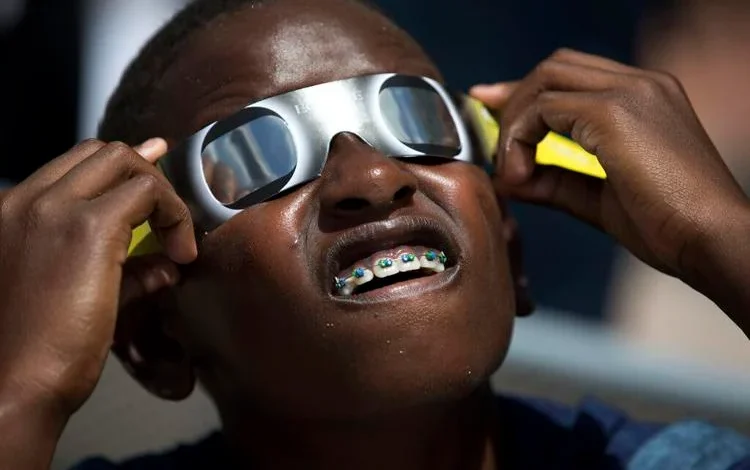How to Make Eclipse Glasses A Comprehensive Guide

Introduction to Eclipse Glasses
How to Make Eclipse Glasses are essential for safely viewing solar eclipses. This guide will take you through the process of making your own eclipse glasses, ensuring you can observe this spectacular astronomical event safely and effectively.
Solar Eclipses
What is a Solar Eclipse?
A solar eclipse occurs when the Moon passes between the Sun and Earth, blocking all or part of the Sun’s light. Viewing a solar eclipse without proper eye protection can cause serious eye damage or even blindness. Eclipse glasses are specially designed to protect your eyes during this event.
Importance of Proper Eye Protection
Why is it crucial to use eclipse glasses? The Sun emits harmful ultraviolet (UV) and infrared (IR) radiation that can damage your eyesight permanently. How to Make Eclipse Glasses are made with materials that filter out these harmful rays, allowing you to view the eclipse safely.
Materials Needed
Before you begin making your How to Make Eclipse Glasses gather the following materials:
- Solar Viewing Film: A specialized film that filters out harmful radiation while allowing you to see the Sun.
- Cardboard: For creating the frame and temples of the glasses.
- Tape: Strong, durable tape to secure the film to the cardboard.
- Scissors: For cutting out the glasses frames and other materials.
- Ruler and Pencil: For measuring and marking the cardboard accurately.
Step-by-Step Guide to Making How to Make Eclipse Glasses
Step 1: Measure and Cut Cardboard Frames
- Measurements: Use a ruler and pencil to outline the shape of the glasses frames on the cardboard. Typical dimensions are based on standard sunglasses, ensuring adequate coverage of your eyes.
- Cutting: Carefully cut out the frames, ensuring smooth edges for comfort when wearing.
Step 2: Attach Solar Viewing Film
- Secure the Film: Cut a piece of solar viewing film slightly larger than the lens area of each frame.
- Tape Application: Use tape to carefully secure the film to the inside of each frame. Ensure there are no gaps or wrinkles that could obstruct your view of the Sun.
Step 3: Create Temples (Arms) for the Glasses
- Cardboard Strips: Cut two long strips of cardboard for the temples (arms) of the glasses.
- Attachment: Tape or glue one end of each strip to the sides of the glasses frames, ensuring they extend past your ears for a secure fit.
Step 4: Test Your Eclipse Glasses
- Safety Check: Before using your eclipse glasses, perform a safety check by looking at a bright light source (not the Sun) to ensure there are no gaps or defects in the film.
- Fit Check: Put on the glasses and adjust the temples for a comfortable and secure fit. You should only be able to see the Sun through the solar viewing film.
Tips for Viewing a Solar Eclipse Safely
Timing and Location
- Location: Find a suitable location with a clear view of the sky and minimal obstruction from buildings or trees.
- Timing: Check the exact time and duration of the solar eclipse in your region to plan your viewing experience accordingly.
Proper Usage
- Wearing Glasses: Always wear your eclipse glasses when looking directly at the Sun during the eclipse.
- Duration: Limit direct viewing time to brief intervals, taking breaks to rest your eyes.
Conclusion
By following this guide, you can create your own eclipse glasses and safely observe solar eclipses. Remember, protecting your eyes is paramount when viewing astronomical events like a solar eclipse. Enjoy the experience responsibly and marvel at the wonders of the universe!
FAQs:
What are eclipse glasses?
Eclipse glasses are specially designed eyewear that allows you to safely view solar eclipses. They are equipped with solar viewing film that filters out harmful ultraviolet (UV) and infrared (IR) radiation from the Sun.
Why do I need eclipse glasses?
It’s crucial to use eclipse glasses because directly viewing the Sun without proper eye protection can cause permanent eye damage, including blindness. How to Make Eclipse Glasses ensure your eyes are protected while you enjoy the spectacle of a solar eclipse.
How do eclipse glasses work?
Eclipse glasses work by using solar viewing film that blocks harmful solar radiation, such as UV and IR rays, while allowing safe viewing of the Sun. The film is specially designed to filter out most of the Sun’s light, making it safe for your eyes.
Can I reuse eclipse glasses?
Yes, if your How to Make Eclipse Glasses are in good condition and the solar viewing film is intact without any scratches or tears, you can safely reuse them for future solar eclipses. Always perform a safety check before each use to ensure they are still effective.
How do I know if my eclipse glasses are safe?
To ensure your How to Make Eclipse Glasses are safe:
- Check for certification: Look for ISO 12312-2 certification, which ensures the glasses meet international safety standards for solar viewing.
- Inspect the lenses: Before each use, inspect the lenses for any scratches, holes, or damage that could compromise their effectiveness.
- Perform a test: Use the glasses to look at a bright light source (not the Sun) to ensure there are no gaps or defects in the solar viewing film.
Can I make my own eclipse glasses?
Yes, you can make your own How to Make Eclipse Glasses using materials like cardboard, solar viewing film, tape, and scissors. Follow a guide like the one provided to ensure you create glasses that meet safety standards for viewing solar eclipses.
What should I do if I don’t have eclipse glasses?
If you don’t have How to Make Eclipse Glasses, there are alternative ways to safely view a solar eclipse:
- Use a pinhole projector: Create a pinhole projector using a cardboard box or similar materials to project an image of the eclipse onto a surface.
- Use a solar viewer: Use a telescope or binoculars with a solar filter that covers the front aperture to safely view the Sun.
When is it safe to remove eclipse glasses during a solar eclipse?
It is safe to remove your How to Make Eclipse Glasses only during the brief period of totality if you are in the path of a total solar eclipse. Totality is when the Moon completely covers the Sun, and it is safe to view the Sun’s corona with the naked eye. However, How to Make Eclipse Glasses must be worn before and after totality to protect your eyes.



